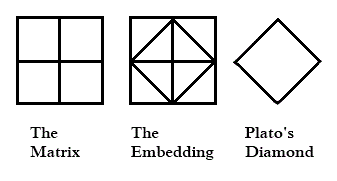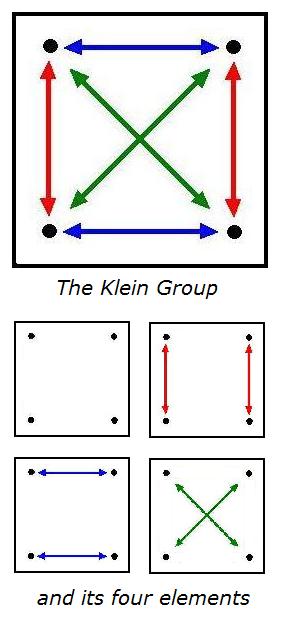Gallic Clarity
Yesterday’s entry Deep Structures discussed the “semiotic square,” a device that exemplifies the saying “If you can’t dazzle ’em with brilliance, then baffle ’em with bullshit.”
A search today for what the Marxist critic Fredric Jameson might have meant by saying that the square “is capable of generating at least ten conceivable positions out of a rudimentary binary opposition” leads to two documents of interest.
1. “Theory Pictures as Trails: Diagrams and the Navigation of Theoretical Narratives” (pdf), by J.R. Osborn, Department of Communication, University of California, San Diego (Cognitive Science Online, Vol.3.2, pp.15-44, 2005)
2. “The Semiotic Square” (html), by Louis Hébert (2006), professor, Université du Québec à Rimouski, in Signo (http://www.signosemio.com).
Shown below is Osborn’s picture of the semiotic square:

Osborn’s discussion of the square, though more clear than, say, that of Rosalind Krauss (who reverses the bottom two parts of the square– see
Deep Structures), fails. His Appendix A is miserably obscure.
On the brighter side, we have, as a sign that Gallic clarity still exists, the work of Hébert.
Here is how he approaches Jameson’s oft-quoted, but seemingly confused, remark about “ten conceivable positions”–
1. ABSTRACT
The semiotic square, developed by Greimas and Rastier, is a means of refining oppositional analyses by increasing the number of analytical classes stemming from a given opposition from two (life/death, for instance) to four (for example, life, death, life and death (the living dead), and neither life nor death (angels)) to eight or even ten.
2. THEORY
The actantial model, isotopy and the semiotic square are undoubtedly the best-known theoretical propositions that have emerged from the Paris School of semiotics, with Greimas as its central figure. Like the actantial model and the veridictory square, the semiotic square is designed to be both a conceptual network and a visual representation of this network, usually depicted in the form of a “square” (which actually looks like a rectangle!). Courtés defines it as the visual representation of the logical structure of an opposition (cf. Courtés, 1991, 152). The semiotic square is a means of refining oppositional analyses by increasing the number of analytical classes stemming from a given opposition from two (for instance, life/death) to four (for example, life, death, life and death (the living dead), and neither life nor death (angels)) to eight or even ten. Here is an empty semiotic square.
Structure of the semiotic square
| |
|
5. (=1+2) COMPLEX TERM
|
|
|
| |
| 1. TERM A |
|
2. TERM B
|
| |
9. (=1+4)
10. (=2+3)
|
|
| 3. TERM NOT-B |
|
4. TERM NOT-A
|
|
|
|
|
7. (=1+3)
POSITIVE DEIXIS
|
8. (=2+4) NEGATIVE DEIXIS
|
| |
|
| |
|
6. (=3+4) NEUTRAL TERM
|
|
|
LEGEND:
The + sign links the terms that are combined to make up a metaterm (a compound term); for example, 5 is the result of combining 1 and 2.
2.1 CONSTITUENT ELEMENTS
The semiotic square entails primarily the following elements (we are steering clear of the constituent relationships of the square: contrariety, contradiction, and complementarity or implication):
1. terms
2. metaterms (compound terms)
3. object(s) (classified on the square)
4. observing subject(s) (who do the classifying)
5. time (of the observation)
2.1.1 TERMS
The semiotic square is composed of four terms:
Position 1 (term A)
Position 2 (term B)
Position 3 (term not-B)
Position 4 (term not-A)
The first two terms form the opposition (the contrary relationship) that is the basis of the square, and the other two are obtained by negating each term of the opposition.
2.1.2 METATERMS
The semiotic square includes six metaterms. The metaterms are terms created from the four simple terms. Some of the metaterms have been named. (The complex term and the neutral term, despite their names, are indeed metaterms).
Position 5 (term 1 + term 2): complex term
Position 6 (term 3 + term 4): neutral term
Position 7 (term 1 + term 3): positive deixis
Position 8 (term 2 + term 4): negative deixis
Position 9 = term 1 + term 4: unnamed
Position 10 = term 2 + term 3: unnamed
|
These ten “positions” are apparently meant to explain Jameson’s remark.
Hébert’s treatment has considerably greater entertainment value than Osborn’s. Besides “the living dead” and angels, Hébert’s examples and exercises include vampires, transvestites, the Passion of Christ, and the following very relevant quotation:
“Simply let your ‘Yes’ be ‘Yes,’ and your ‘No,’ ‘No’; anything beyond this comes from the evil one.” (Matthew 5:37)













 .
.


















